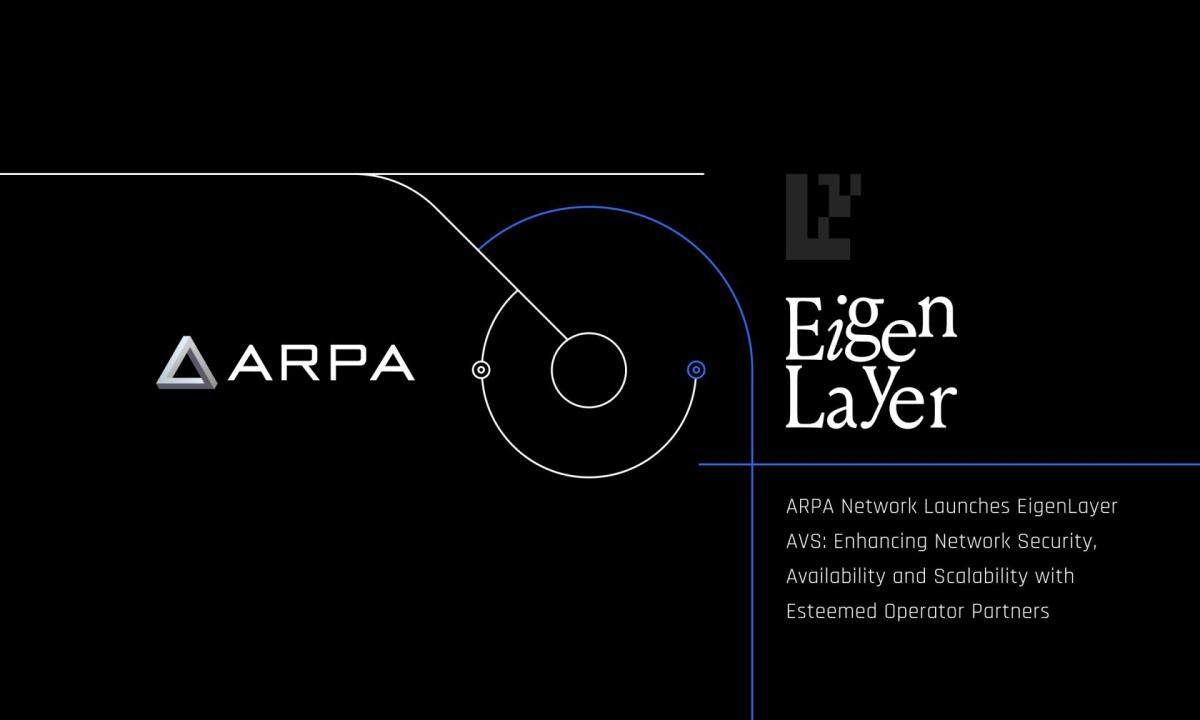
Singapore, Singapore, June 12th, 2024,
Chainwire
ARPA Network has launched an EigenLayer-secured Actively Validated Service
(AVS), marking a
significant step in its multi-chain expansion. This integration
aims to strengthen the security, availability, and scalability of
the ARPA Network. Additionally, over 20 esteemed operator partners
have been onboarded to enhance ARPA Network's infrastructure.
What is EigenLayer and AVS?
EigenLayer is a protocol built on Ethereum that pioneers
restaking, a new concept in crypto-economic security. At its
essence, EigenLayer comprises a suite of smart contracts enabling
users to restake their natively staked ETH or liquid staking tokens
(LST), and bootstrap new proof-of-stake (PoS) networks and
services. In return, restakers can earn additional staking rewards,
which are currently recorded in the form of points.
EigenLayer’s architecture includes four key components: actively
validated services (AVS), restakers, operators, and AVS consumers.
As one of the AVSs, the ARPA BLS Threshold Signature Scheme
(BLS-TSS) Network is a decentralized network composed of multiple
dynamic groups of nodes that securely generate BLS threshold
signatures. Randcast, ARPA Network's first product, provides secure
and reliable random number generation on multiple blockchains.
Other AVSs include data availability layers, shared sequencers,
oracle networks, bridges, coprocessors, applied cryptography
systems, and more.
How Does EigenLayer’s Mechanism
Function?
In simple terms, AVS consumers, typically dApps, request
computation tasks from AVSs, which in turn seek a range of services
from operators. Operators receive restaked ETH or LST delegations
from restakers, operate specialized node software, and execute
tasks for AVSs. This approach facilitates Ethereum's “shared
security” among a broader spectrum of developers in a more
streamlined manner.
Reasons for Integrating EigenLayer
Enhanced Security. ARPA Network features robust
security through the architecture of dynamic node groups that
reduce reliance on centralized authorities. With the integration of
EigenLayer, ARPA Network fortifies its security infrastructure by
leveraging Ethereum’s shared security. It aligns with EigenLayer’s
notion of Dual Staking, which
utilizes staking of two tokens - ARPA native staking and ETH
restaking - to guarantee the security of ARPA Network. This
enhancement cultivates a more reliable environment for ARPA
Randcast users.
Advanced Availability. The addition of
more nodes increases the number of available groups, which improves
the network’s fault tolerance. This ensures a higher probability of
task execution, enabling users to achieve superior service
quality.
Improved Scalability. EigenLayer optimizes
security resource allocation, allowing operators to secure multiple
protocols efficiently simultaneously. By collaborating with
additional operator partners within the EigenLayer ecosystem
alongside ARPA's existing staking mechanism, ARPA Network advances
its scalability, stability, and sustainability. This strategic
alignment empowers Randcast users with enhanced service scope.
Potential Applications of EigenLayer, ARPA Network, and
Randcast
We all acknowledge that randomness is ubiquitous and essential
in autonomous worlds. From the infrastructure to decentralized
applications, fairness ensured by randomness is the basis of all
rules. Therefore, with the foundation being enhanced by EigenLayer,
ARPA Network and Randcast are better positioned to serve the
builders across many fields, including but not limited to the
following:
Games. Randcast enhances the gaming experience
by guaranteeing fairness and randomness in random elements of
games, such as character attributes, item properties, matchmaking,
map generation, event outcomes, divination, and sometimes winner
drawing.
NFTs. Randomly assigned rarity tiers in NFT
series are crucial. Users need assurance that the results are
generated by tamper-proof randomness.
Blockchain Consensus. Builders can integrate
Randcast into the consensus layer, adding a modular random beacon
for the blockchains they develop.
Marketing & Community Campaigns. Leveraging
Randcast, builders can create marketing tools to randomly select
community giveaway winners, customizing weighting metrics such as
engagement and token staking.
DAO Governance. Randcast can certify a fair
random sample voting process, ensuring that the opinions of a
larger Web3 community are adequately represented.
Collaborations and Future Outlook
The launch of ARPA Network AVS on EigenLayer is supported by
numerous operator partners with over 4.5 million ETH (approximately
$16 million) in restaking. This collaboration aims to enhance ARPA
Network's security, availability, and scalability, providing
superior services to Randcast users and empowering Web3
builders.
ARPA Network's journey of exploration and expansion across
multiple ecosystems will continue. Our dedication to empowering
Web3 builders with robust and secure infrastructure, along with
standardized and modularized randomness functionalities, will only
strengthen. Stay tuned for further updates!
About ARPA Network
ARPA Network (ARPA) is a decentralized secure
computation network built to improve the fairness, security, and
privacy of blockchains. ARPA threshold BLS signature network serves
as the infrastructure of verifiable Random Number Generator (RNG),
secure wallet, cross-chain bridge, and decentralized custody across
multiple blockchains. ARPA is backed by Binance Labs, Arrington
Capital, DWF, and several other funds.
Contact
Elliot
Ledley
Elliot@Energentmedia.net